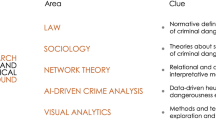Abstract
Criminal intelligence data poses problems for conventional database technology. It has little structure or homogeneity and queries may involve looking for unknown associations between entities; such open-ended queries cannot be made in current systems. Finally, the data must be presented in an intuitively simple fashion for both investigative and evidential purposes. We discuss a database system which uses a labelled graph as its data model. This approach obviates the need for schema design, allows queries which look for associations between entities to be implemented and provides the basis for a natural visual representation of the data.
Similar content being viewed by others
References
Abreu, R. (1995)A visual query interface to the association functional database language Hydra. Master’s thesis, Birkbeck College, University of London.
Abrial, J. R. (1974) Data semantics. In Klimbie, Koffeman (eds.),Data Base Management, North Holland. 1–59.
Ayres, R. (1995a)Enhancing the Semantic Power of Functional Database Languages. PhD thesis, Birkbeck College, University of London.
Ayres, R and Abreu, R. (1997)Visualq, A graphical interface to facilitate database exploration. Submitted for Publication.
Ayres, R and King, P. (1995b) Enhancing functional database query languages with associational features.Ingenierie des systemes d’information. 3(2–3), 441–463
Ayres, R and King, P. (1996) Querying graph databases using a functional language extended with second order facilities. In Morrison, Kennedy (eds.)Advances in Databases, 14th British National Conference on Databases, BNCOD 14, Springer-Verlag.
Buneman, P., Frankel, R. E. (1979) FQL—a functional query language. In Bernstein (ed.)Proceedings ACM SIGMOD 79 Conference, ACM.
Chen, P. P. S. (1976) The Entity-Relationship Model, Towards a Unified View of Data.ACM Transactions on Database Systems. 1(1), 9–36
Frost, R. A. (1982) Binary relational storage structures.The Computer Journal. 28(5), 359–367
Hall, P., Owlett, J., Todd, S. (1976) Relations and entities. In Nijssen (ed.)Modelling in Data Base Management Systems, North Holland.
Kent, W. (1979) Limitations of record-based information models.ACM Transactions on Database Systems. 4(1), 107–131
Lehmann, F. (1992) Semantic networks.Computers and Mathematics with Applications, 23, 1–50
Libes, D. (1995)Exploring Expect. O’Reilly and Associates.
Maguire, M., John, T. (1995)Intelligence, Surveillance and Informants, Integrated Approaches. Home Office Police Department, London.
Ousterhout, J. K. (1994)Tcl and the Tk Toolkit. Addison-Wesley.
Poulovassilis, A., King, P. (1990) Extending the functional data model to computational completeness. InProceedings of EDBT90, Springer-Verlag, LNCS 416.
Shipman, D. (1981) The functional model and the data language DAPLEX.ACM Transactions on Database Systems. 6(1), 140–73
Turner, D. A. (1985) Miranda, a non-strict functional language with polymorphic types. In Jouannaud (ed.)Functional Programming Languages and Computer Architectures. Springer-Verlag, LNCS 201.
Wasserman, S., Faust, K. (1994)Social Network Analysis: Methods and Applications. Cambridge University Press.
Author information
Authors and Affiliations
Corresponding author
Rights and permissions
About this article
Cite this article
Ayres, R. Databases for criminal intelligence analysis: Knowledge representation issues. AI & Soc 11, 18–35 (1997). https://doi.org/10.1007/BF02812436
Issue Date:
DOI: https://doi.org/10.1007/BF02812436




